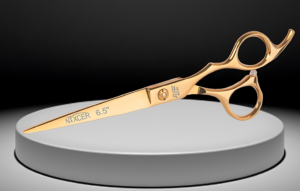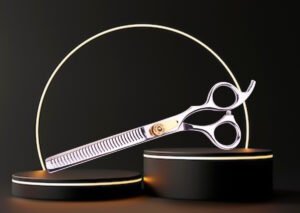Thick hair differs from other types due to its density and coarse texture, making it more resistant to cutting and styling. Unlike fine or thin hair, thick hair requires more effort to achieve smooth, precise cuts. Special scissors, such as those with convex blades and a longer length, are recommended for thick hair. These scissors are sharper, more robust, and designed to handle larger hair sections without tugging or damaging the strands, ensuring clean, even cuts. The right scissors provide better control, reduce hand strain, and enhance overall cutting efficiency when working with thick hair.
How to Choose Hair Cutting Scissors for Thick Hair
In this guide we will explain how to choose the professional hair cutting scissors specifically designed for thick hair.
1. Blade Type
Convex blades are the sharpest type available and are ideal for cutting thick hair. They have a slightly curved edge, which makes them perfect for slicing, point cutting, and other advanced techniques. The sharpness of convex blades allows them to cut through thick hair smoothly without pushing or bending the hair, resulting in a cleaner cut and a better finish.
Beveled Edge blades are also suitable for thick hair, though they are not as sharp as convex blades. They have micro-serrations that help grip the hair, making them better suited for blunt cuts on thick hair.
2. Scissor Size
The length of the scissors is particularly important when dealing with thick hair. Longer blades are designed to cut larger sections of hair at once, improving efficiency and control. This size is especially useful for techniques such as scissor-over-comb, which are often used when working with thick hair.
While shorter scissors are typically used for more precise, detailed work, they may struggle with thick hair. The extra effort required to repeatedly cut through dense sections can lead to uneven cuts and hand fatigue.
3. Handle Design
Ergonomic handles, such as offset or crane-style designs, are essential for comfort, especially during long cutting sessions. These handles allow your hand and wrist to maintain a more natural position, reducing strain and the risk of repetitive stress injuries.
Offset handles provide a slight angle that allows for a more natural hand position, reducing fatigue. They are especially beneficial for stylists who spend a lot of time cutting thick hair.
Crane handles provide even more ergonomic benefits by allowing the stylist’s elbow to drop into a more relaxed position, further reducing shoulder and wrist strain.
4. Blade Material
The material of the blades plays a significant role in performance and longevity. High-quality stainless steel is durable, resists corrosion, and maintains sharpness, making it ideal for thick hair. Japanese steel, known for its superior sharpness and strength, offers an even higher quality option. It holds its edge longer, reducing the need for frequent sharpening.
Titanium-Coated blades provide additional durability and a smooth cutting action. Titanium coating can reduce friction, making the scissors glide effortlessly through thick hair.
5. Tension Adjustment
Tension control is crucial when working with thick hair. An adjustable tension screw allows you to customize the tightness of the blades. Proper tension ensures the scissors work smoothly without snagging, allowing for effortless cutting. Too tight, and the scissors may be difficult to operate; too loose, and they may bend or fold the hair rather than cut it cleanly.
Some high-end scissors come with a ball-bearing system that offers smoother tension adjustment, providing an even more refined cutting experience, especially with thick hair.
6. Weight
The weight of the scissors can greatly affect your cutting experience. A well-balanced pair of scissors will feel comfortable and controlled in your hand. For thick hair, a slightly heavier pair can help you maintain control over the cut, especially when working with large sections.
While lightweight scissors reduce hand fatigue, they may lack the control needed for thick hair. A balanced weight offers the right mix of control and comfort.
7. Finger Rest
A finger rest provides extra stability and control, which is particularly beneficial when cutting thick hair. The tang helps maintain balance, ensuring each cut is smooth and controlled, reducing strain on the stylist’s hand.
Some scissors allow for the tang to be adjusted or removed based on personal preference, offering a customizable fit for comfort.
8. Micro-Serrated vs. Plain Blades
Micro-serrated blades are designed to grip fine hair, making them less suitable for thick hair. They can cause the blades to drag through dense hair, leading to uneven cuts. Instead, opt for plain or convex blades, which glide effortlessly through thick hair, providing a smooth and precise cut.
9. Price and Quality
Scissors for thick hair are a long-term investment. High-quality professional scissors offer superior sharpness, durability, and comfort. Although they may have a higher initial cost, their performance and longevity make them worthwhile, particularly when handling thick, dense hair.
Look for well-known brands like Kamisori, Matsui, or Joewell, which are renowned for their quality and performance in professional hairdressing tools.
Final Thoughts
Selecting the right hair cutting scissors for thick hair is essential for achieving precise, clean, and efficient cuts. Focus on sharpness, ergonomic design, blade material, and proper tension adjustment to ensure your scissors can handle the density and texture of thick hair. Investing in high-quality scissors tailored to thick hair not only improves your cutting results but also enhances the overall cutting experience by reducing hand strain and ensuring a smoother workflow.



